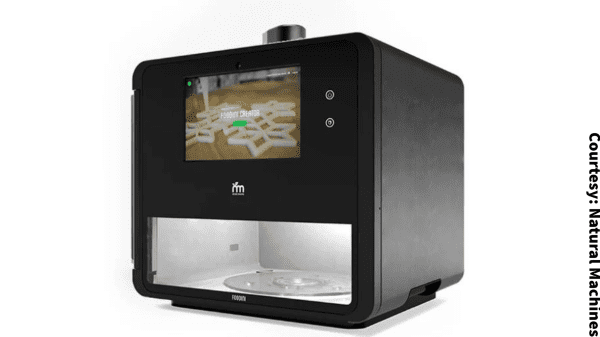The advent of 3D printing has been hailed as a new Industrial Revolution.
It involves programming a machine to squirt out streams of some kind of paste in a precise manner so as to come up with a finished product — even machine parts. Anything that can be turned into a paste or a semi-liquid is a candidate for 3D printing.

3D printed food reached a watershed last year, when an Israeli bioprinting company announced that it had produced a 104-gram (3.67-ounce) bioprinted steak. It’s made of cultured meat, “produced from beef cells by taking a biopsy from a living cow and growing it in a nutritious medium until there’s enough critical mass to make the cells into bio-ink. The bio-ink is then printed using the company’s bio-printer,” says Food Safety News.
Yuk.
Implications for the produce industry: bioprinted fruits and vegetables are highly feasible creations. The Food Safety News article even shows a photo of a bioprinted pear, which looks very much like the real thing.
“Fruits and vegetables are non-printable raw materials, so their flow properties and viscosity must be improved by additives to produce a printable paste,” notes a scholarly paper on the subject. “The solution to this difficulty has been found in the use of texture-stabilizing additives or thickeners. Here, good water retention, transparency and aging resistance have advocated the use of texture-stabilizing additives or thickeners,” such as pectin, isinglass, and potato starch.
In short, 3D printed fruits and vegetables are not going to be “natural” in any meaningful sense. They will be added to the range of processed products, such as frozen and shelf-stable items.
As for a bioprinted pear that looks and tastes like a pear, what’s the point? Why not just eat a pear?
3D food printers are already for the home, with names like Mucuisini and Procusini. Here this technology could have a real future, although mostly for niche purposes. I could see home and even professional cake decorators and chocolatiers making some delightful and ingenious creations.
But it’s a little hard to imagine a homemaker really wanting to extrude something out of a tube into a machine to have it spit out a steak.
There’s also the matter of food safety. Food Safety News observes, “No problems with food safety, say the printers’ advocates, but that’s only if the food has been prepared in a machine that’s sterile and if the preparer follows sanitary procedures. No different from what’s necessary in any kitchen.”
Except, we go on to read:
“A 3D printed part can turn into a petri dish squirming with bacteria within weeks. Even though some materials will survive the dishwasher, so will dangerous bacteria such as E. coli and Salmonella that live in the little nooks and crannies. Some toxic molds find favorable growth conditions on several types of plastic and are hard to remove. Neither cleaning with bleach nor microwaving is an option for eliminating germs.”
Is home sterilization feasible? Yes, of course. Home canners have been doing it for generations.
But none of this is adding up to the kind of convenience and ease that the harried consumer wants. And I do not imagine those tubes of meatlike protein and fruit paste are going to be much, if at all, cheaper than their non-ersatz equivalents.
My impression is this: except for a few niche areas (such as confection), the 3D printer is not likely to make it into the mainstream of home appliances. If it is adopted, it is likely to go the way of that garage-sale staple known as the pasta machine.
On an industry level, 3D printed fruits and vegetables may add to the competition for their fresh equivalents in that 3D products could take their place alongside frozen and shelf-stable products as alternatives.
Note too the mention of “additives” above. Who’s to keep one of these additives from being sugar? This kind of 3D “fruit” could take a healthy item and push it into the category of junk foods.



